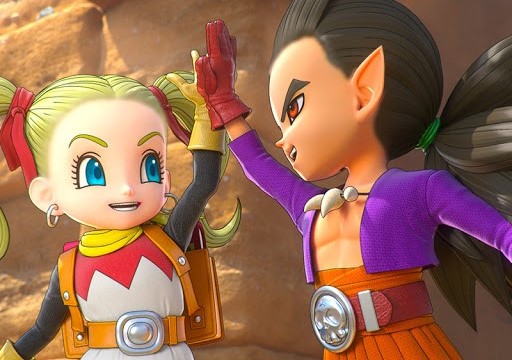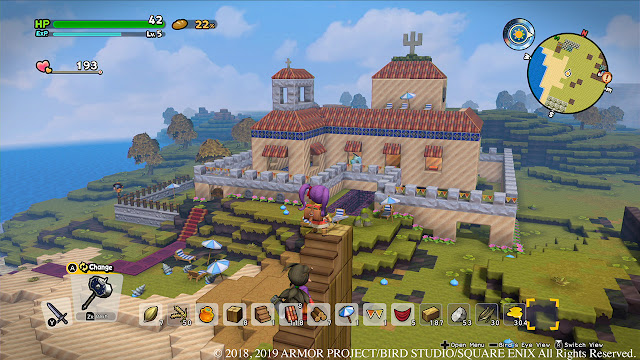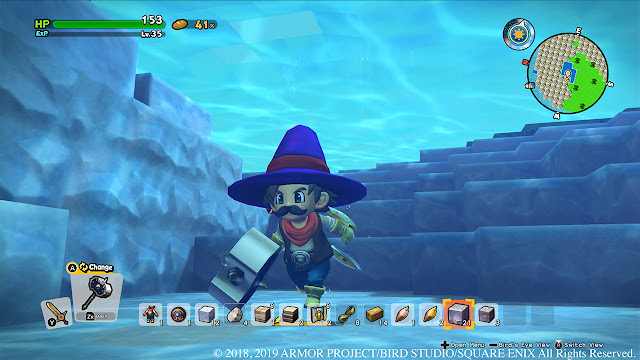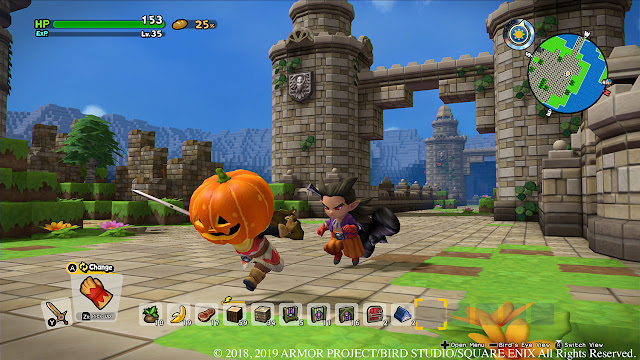Game Theory by Matt C.
One of the most common complaints about the original Dragon Quest Builders—an otherwise excellent game—was the way its story mode impeded the sense of progress. In short, the story was divided into four completely separate chapters, each of which started you from scratch in terms of character progress. Once you completed one chapter, you’d go into the next one with your inventory all your learnt recipes left behind.
I actually quite liked this setup, personally; it allowed each chapter to focus on different aspects of the game’s vast building system, without getting you overwhelmed with the sheer volume of recipes available. I’d also argue that it has more progression than most give it credit for, just not in a literal character-stats sort of way. Rather, it’s designed around a progression of game concepts: the first chapter gives you a general overview of the block-building concept; the second builds on that with farming and water use; the third introduces metals and machinery; and the fourth (and final) chapter challenges you to put all those lessons to work with limited resources.
Still, I can see why people were upset. You spend a lot of time per chapter, expanding your repertoire of recipes and collecting all manner of different materials, only to have those left behind when you move onto the next chapter. A separate “free build” mode of sorts with all unlocked recipes from all chapters, while plenty enjoyable in its own right, doesn’t quite make up for the cooling effect of effectively having to start from scratch at the beginning of each new chapter.
Clearly, Square Enix heard those complaints, because Dragon Quest Builders 2’s story mode has a very different structure, one that puts literal character progression at the centre. But it doesn’t just abandon the first game’s approach entirely; rather, it cleverly combines the best of both worlds: a progression of ideas with deliberate limitations to draw attention to different things, alongside a persistent, ongoing sense of your character going from strength to strength.
In Dragon Quest Builders 2, rather than completely discrete chapters, the game and story is segmented across a variety of different islands. Your journey begins with you waking up stranded on the aptly-named Isle of Awakening, and this island serves as a sort of hub for the rest of the game. From there, story progression gradually opens up new islands to visit, each with new materials and learn new recipes, but you always come back to the Isle of Awakening with all your new stuff, and the freedom to really play around with it. In practice, it works similarly to Dragon Quest Builders’ Terra Incognita (free build mode, essentially), but rather than being a completely separate mode like Terra Incognita was, the Isle of Awakening is a key part of the story that unfolds over the course of Dragon Quest Builders 2. It has its own story arcs that feed into the overarching plot, its own characters and developments, and its own goals and challenges.
The rest of the story plays out across three other major islands, and it’s here that Dragon Quest Builders 2 is most reminiscent of its predecessor. Before setting sail for a new island, your entire inventory is stored at the dock for the (admittedly flimsy) reason that your ship can’t carry the weight. This has a similar effect as the first game’s compartmentalised chapters—you’re arriving at a new area with empty bags—but you always know that the rest of your stuff is waiting for you when you get back to the Isle of Awakening.
Similarly, you arrive at each new island with limited ability to actual build stuff. However, it’s not because you’ve forgotten recipes you’d learnt previously, as was the case in Dragon Quest Builders, but simply just that you haven’t yet had a chance to discover new recipes that use new materials for a similar function to what you’d previously learnt. Functionally, a wall block is a wall block regardless of what it’s made of, but just because you’d learnt to make wooden walls on a woodland island doesn’t mean that you can automatically make stone or metal walls when you arrive at an abandoned mining town in the middle of a desert.
Essentially, the effect is more or less the same as what Dragon Quest Builders did: at the start of each new “chapter”, you’ve got an empty inventory and a recipe book with very few recipes that you can actually make use of, which then allows the game to explore new ideas and introduce new concepts without undermining game balance or overwhelming you with stuff. But there’s a big psychological difference: you’re not being stripped of your progress; you’re just setting some things aside for a moment so you can learn new things and continue to develop as a builder.
And then, after completing an island’s story, you get to take all those new materials back to the Island of Awakening, giving you more ways of building your paradise and new challenges that make use of your newfound stuff. On top of that, once an island’s story is complete, you can freely revisit it from then on—without being forced to leave your inventory behind (apparently your boat is fine with the extra load when you’re not charting new waters).
Changes to how your character gets stronger in combat also help to foster a constant sense of progression in Dragon Quest Builders 2. In the first game, your only way of getting stronger was by crafting better equipment, which got reset at the start of each chapter along with everything else. This time around there’s a traditional RPG levelling system, and as well as getting HP increases with every level up, you also learn new equipment recipes every few levels. More significantly, your gear is never lost, even when all the rest of your inventory has to be stored at the dock; anything that you have equipped stays with you, until you replace it with something stronger.
This applies to the various tools you use to gather materials, too. In Dragon Quest Builders, things like your mallet—a vital piece of equipment for breaking blocks out in the world—were treated just like any other weapon, and fell victim to your character’s amnesia in much the same way. In Builders 2, those tools are treated more like Zelda-esque permanent upgrades. Once you find the mallet, you’ve got it forever. Once you’ve strengthened it (as a necessary part of story development), you’ve got the powered-up version forever. There’s no losing your tools alongside the rest of your items, and no need to re-learn the same old recipes in a new chapter just to get a mallet of the same strength as what you had before.
All of these changes combine to make Dragon Quest Builders 2 feel like a much more continuous, coherent game than the distinct chapters of the first game. This time, there’s a constant sense of character growth as you learn new recipes and then get to keep them—even if old recipes may not be immediately useful in a new setting with new materials, they’re still there in your recipe book, ready to be utilised again as soon as you’re able to find the appropriate stuff.
With this reframing, Builders 2 gets to retain the benefits of the first game’s completely isolated chapters—a gradual progression of design concepts that you’re guided through, with limitations that forced you to explore those new ideas—but it does so without the wholesale disempowerment that came with just having everything taken away from you at the start of each new chapter. This time, there’s a constant sense of character growth from start to finish, which is the one thing the first game was missing.
– Matt C.
Contributor











